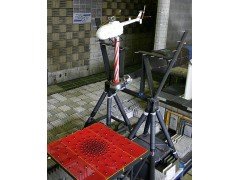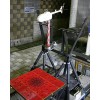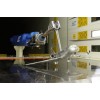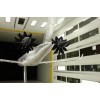Environment perceived measured noise
aeroacousticsupdatervar1000FNoise pollution has become an item of frequent and sometimes intense political, social and economic debate, in particular in densely populated areas around airports. Aircraft noise is created by propulsion units as well as by airframe components such as undercarriages, slats and flaps.
DNW offers state-of-the-art technologies for measuring noise generation and the related reduction mechanisms for full-size, full-span models or a wide range of components of aircraft and helicopters. Measurement of the noise of an aircraft as perceived by the environment is important in ensuring take-offs and landings within permissible noise levels.
Balance between aeroacoustic and aerodynamic aspects
Measurement techniques focus on the source and the nature of the noise and are capable of distinguishing between individual sources thanks to diagnostic acoustic arrays consisting of multiple microphones. Correlation and phase analysis of the signals of these arrays enable the strength and location of relevant noise sources to be determined. Moreover, microphone array systems allow parallel measurements of forces and pressures, providing information that can be used in design optimization wher noise and aerodynamic aspects need to be balanced. Parallel measurements also allow substantial time and cost savings.
Precision crucial for acoustic tests
Representative simulation of noise sources and accurate determination of noise emission requires a trade-off between acceptable model sizes and the dimensions of test volumes. Models that are too small generate frequencies far beyond the audible range of up to 20 kHz (since sound frequencies are inversely proportional to the model scale). At the same time, models need to be sufficiently large to have representative flow properties in terms of Reynolds number criteria. Models need to comprise all relevant components (fans, slats and flaps as well as jets) in order to be tested under take-off and landing conditions. DNW’s large tunnel with open and closed test sections with dimensions of 6 m x 8 m x 19 m (h x w x l) offers an adequate configuration for this type of testing.
In addition to their size, model details are an important factor in acoustics testing, because any rough surface such as improperly finished bolts can produce unacceptable noise levels that have a seriously negative impact on test results. At the same time, however, aeroacoustic effects of protrusions such as flaps and wheels must be measured meticulously, because they are the largest source of noise during landing, rather than the engines, which are usually operated at low-thrust conditions and therefore produce little noise at that stage of flight.
Sophisticated range of techniques
Measurements are performed by means of microphone rakes and arrays. The size of these systems and the number of microphones depend on the frequency range and the size of the test object. Rakes with a limited number of microphones are applied in the LLF open jet tunnel to assess the radiated noise patterns as a function of time and directivity. Stationary or traversable arrays comprising large numbers of microphones can measure between 1 m x 1 m and up to 4 m x 4 m and are applied in open and closed test situations.
Data is collected and processed by DNW’s Dynamic Data Acquisition (DDA)system, consisting of five Viper front-end systems capable of handling 240 microphone channels simultaneously. The DDA system is connected to an external storage system with a capacity of 10 TByte by means of a local network with a transfer rate of 1 Gbit/s. This high-capacity system is capable of parallel measuring and processing of practically unlimited amounts of data at high speed.
Data can be processed and presented in a combination of single source plots to allow rapid determination of sound pressure levels in individual sources. Alternatively, DNW uses the power spectrum integration technique to distinguish quantitatively between individual noise contributions. This latter technique is also useful for comparing wind tunnel data and flight data.













